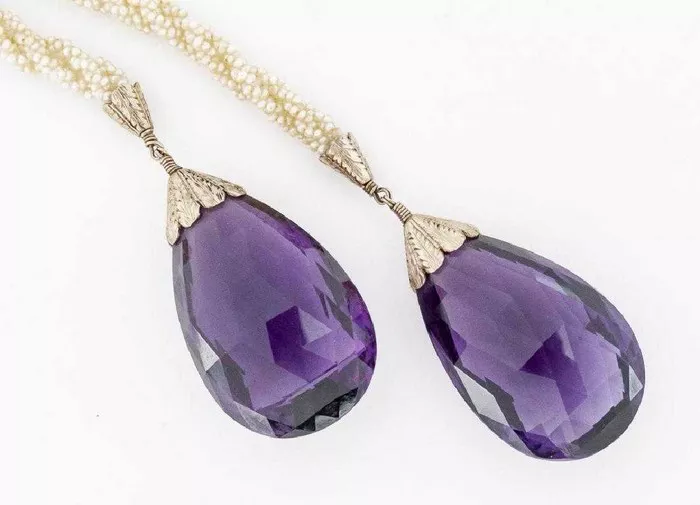Amethyst is a popular and beautiful gemstone that has been cherished for centuries. When it comes to determining the value of amethyst, the color, which can range from light to dark, is a crucial factor. However, simply stating that lighter or darker amethyst is more valuable is a complex matter that requires a more in – depth exploration.
The Nature of Amethyst Color
Amethyst gets its color from the presence of iron and other trace elements within the quartz crystal structure. The intensity of the color can vary greatly depending on the concentration of these elements and the geological conditions in which the amethyst formed. Lighter amethyst may have a more pastel – like hue, while darker amethyst can be a deep, rich purple.
Market Demand for Lighter Amethyst
Aesthetic Appeal
Lighter amethyst has a certain delicate charm. It can be reminiscent of spring flowers or soft twilight skies. For those who prefer a more understated and elegant look, lighter amethyst can be highly desirable. In jewelry design, lighter amethyst can be paired with a wide range of other gemstones and metals, creating a harmonious and sophisticated aesthetic.
For example, in a dainty necklace with white gold and small diamonds, a light amethyst can add a touch of color without being overpowering.
Versatility in Design
Lighter amethyst is often more versatile in jewelry making. It can be used in a variety of styles, from modern minimalist designs to more traditional and ornate pieces. Its soft color allows it to blend well with different color palettes, making it a popular choice for designers who want to create pieces with a broad appeal.
Designers might use light amethyst in a stack of beaded bracelets, combined with pearls and other semi – precious stones, to create a trendy and casual look.
Popularity in Certain Regions and Cultures
In some cultures, lighter colors are associated with purity and grace. This can lead to a higher demand for lighter amethyst in those regions. For instance, in some Asian cultures where pastel colors are highly favored in fashion and jewelry, lighter amethyst may be more sought – after.
Market Demand for Darker Amethyst
Rarity and Intensity
Darker amethyst, especially those with a deep, saturated purple color, is relatively rarer in nature. The intensity of the color gives it a more luxurious and striking appearance. High – quality, dark amethyst can be quite eye – catching, making it a desirable choice for statement jewelry.
A large, dark amethyst ring set in yellow gold can be a show – stopping piece, attracting attention with its rich color.
Symbolism and Perceived Value
In some Western cultures, deeper colors are often associated with wealth and power. Darker amethyst can convey a sense of luxury and sophistication. This perception can drive up the value in the market, as consumers are willing to pay more for a gemstone that they believe represents a higher status.
A dark amethyst pendant worn with an evening gown can add an air of elegance and mystery, appealing to those who want to make a grand impression.
Collectors’ Interest
For gemstone collectors, darker amethyst with exceptional color quality can be a valuable addition to their collections. The rarer the color and the better the clarity, the more appealing it is to collectors. They are often willing to pay a premium price for a piece of dark amethyst that meets their high standards.
Quality Factors Beyond Color
Clarity
Whether an amethyst is light or dark, its clarity plays a significant role in determining its value. Amethyst with few inclusions and a high level of transparency is generally more valuable. A light amethyst with excellent clarity can be just as valuable as a dark amethyst with the same level of clarity, if not more in some cases, especially if it has a unique color characteristic.
Cut
The cut of the amethyst can enhance or detract from its beauty and value. A well – cut amethyst, whether light or dark, will show off its color and sparkle more effectively. A poorly cut amethyst, on the other hand, may not display its true potential, regardless of its color intensity.
Size
Larger amethyst stones are generally more valuable, regardless of their color. However, the combination of size with color, clarity, and cut is what ultimately determines the overall value. A large, light amethyst with good quality in other aspects can be very valuable, as can a large, dark amethyst.
Conclusion
In conclusion, it is not possible to simply state that lighter or darker amethyst is more valuable. Both lighter and darker amethyst have their own unique qualities and market demands. The value of amethyst depends on a combination of factors including color, clarity, cut, and size. Lighter amethyst may be more valuable in some contexts, such as in certain design applications or in regions with a preference for pastel colors. Darker amethyst, on the other hand, may be more valuable due to its rarity, intensity, and the perception of luxury it conveys. Ultimately, when appraising an amethyst, a professional must consider all of these factors to accurately determine its value.
Related topic:
- The Difference Between Amethyst and Clear Quartz
- Amethyst and Rose Quartz: A Gemstone Feast of
- What Is Amethyst Stalactite Eye


